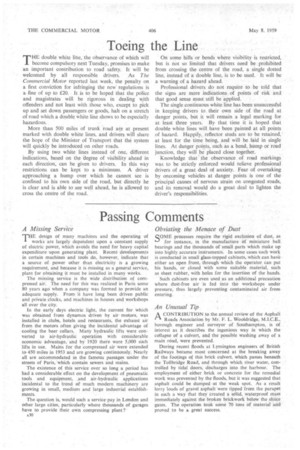Toeing the Line
Page 32

If you've noticed an error in this article please click here to report it so we can fix it.
THE double white lihe, the observance of which will become compulsory next Tuesday, promises to make an important contribution to road safety. It will be welcomed by all responsible drivers. As The Commercial Motor reported last week, the penalty on a first conviction for infringing the new regulations is a fine of up to £20. It is to be hoped that the .police and magistrates will, be rigorous in dealing with offenders and not least with. those who, except to pick up and set down passengers or goods, halt on a stretch of road which a double white line shows to be especially hazardous.
More than 500 miles of trunk road are at present marked with double white lines, and drivers will share the hope of the Minister of Transport that the system will quickly be introduced on other roads.
By using two white lines instead of one, different indications, based on the 'degree of visibility ahead in each direction, can be given to drivers. In this way restrictions can be kept to a minimum. A driver approaching a hump over which he cannot see is confined to his own side of the road, but directly he is clear and is able to see well ahead, he is allowed to cross the centre of the road. Oil some hills or bends where visibility is restricted, but is not so limited that drivers need be prohibited from crossing the centre of the road, a single dotted line, instead of a double line, is to be used. It will be a warning of a hazard ahead.
Professional drivers do not require to be told that the signs are mere indications of points of risk and that good sense must still be applied.
The single continuous white line has been unsuccessful in keeping drivers to their own side of the road at danger points, but it will remain a legal marking for at least three years. By that time it is hoped that double white lines will have been painted at all points of hazard. Happily, reflector studs are to be retained,. at least for the time being, and will be laid in single lines. At danger points, such as a bend, hump or road junction, they will be placed close together.
Knowledge that the observance of road markings was to be strictly enforced would relieve professional drivers of a great deal of anxiety. Fear of overtaking by oncoming vehicles at danger points is one of the principal causes of nervous strain on congested roads, and its removal would do a great deal to lighten the driver's responsibilities.




































































































